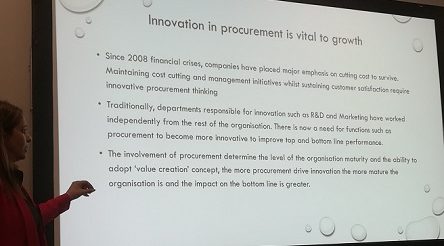Emma Freiha at eWorld – Innovation at Lego and Beyond


We wrote recently about our short interview with Emma Freiha prior to eWorld, so of course we had to go and listen to her session at the actual event.
She joined the firm in 2016 after a previous career as an engineer in the oil industry. She works in procurement, but in “innovation sourcing”, where her main task has been to source sustainable materials to make the core Lego products. That’s part of the firm’s ambitious drive to make the majority of its products sustainable by 2030.
Most of her excellent session was about the general approach to innovation sourcing rather than Lego specifics. Since the financial shocks of the last recession, innovation is returning as a top priority for many firms, she says. However, in many cases, the focus is cautious and incremental, looking to improve current products – but this is broadening now into more step-change innovation, particularly in developing economies. But many corporate cultures are risk averse, with lengthy development cycles and inadequate measurement practices limiting innovation.
Innovation in procurement (from the supply market) is vital for growth, she says. But if procurement is asked to add value in that way, the function must be involved from the start of the process, and procurement must of course be aware of what is happening in the markets from which the firm is seeking innovation.
Innovation Procurement is a sign of corporate maturity, according to an EY study. Maturity is measured by the company “exposure” to innovation and then the level of integration of procurement into the innovation function of the company (in other words, the firm must be serious about seeking innovation from supply markets; and procurement must be integrated into that effort).
So what can prevent procurement achieving this? Freiha suggested the following barriers.
- Budget constraints / lack of resources
- Lack of support from other organisational functions
- Low knowledge of markets and suppliers
- Slow / ineffective decision making internally
- Lack of collaboration across the business
She supports the concept of “open innovation”, which looks beyond the organisation (and existing suppliers, presumably) and is open to new ideas. But, as she says, “procurement must ensure the company is attractive to its most important sources of innovation” and that means looking at risk / reward and relationship management structures. Implementation of innovation also requires change management expertise.
In terms of Lego itself, and the search for sustainable materials, there was a 7-stage innovation process with suppliers going through that “funnel”. They were filtered on aspects such as their current capability and their willingness to invest. And in terms of the “what’s in it for them”? Well, Lego are buying around 10 tonnes a year of the “new” material, but the market is already 150 tonnes or more. Suppliers must be rewarded and incentivised – either directly, or through the further benefits they will get (as in this case) arising from the innovation.
Innovation is rapidly becoming one of the most important topics for procurement. It does not apply to every organisation, and certainly does not apply to every spend category. But where it does have potential, procurement can make a far larger contribution to value and competitive advantage than we ever will through basic cost management. So, I hope we see more impressive people like Freiha in the profession, inspiring others to take the lead on a structured approach to seeking and implementing innovation from the market.
